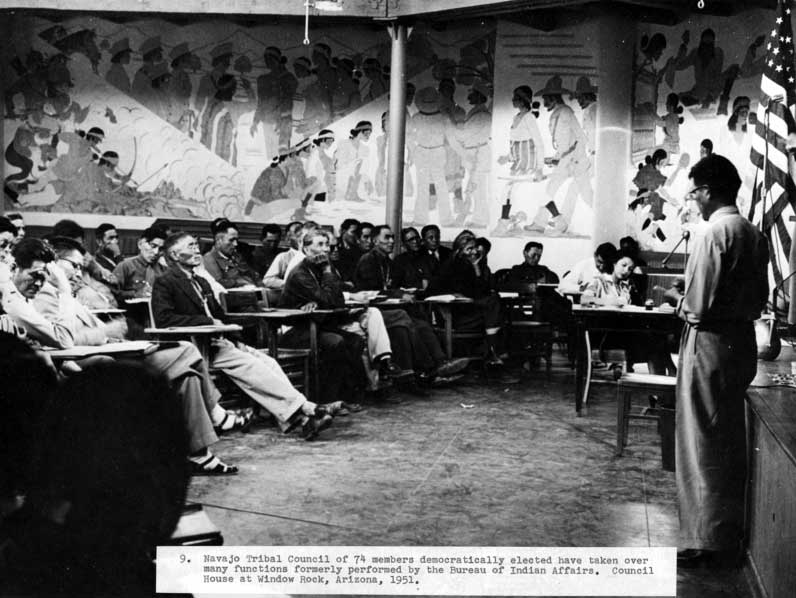
50 Years Ago: Council finally prepares to discuss a constitution

The Navajo Tribal Council originally consisted of 74 elected members who took over duties that had been performed by the Bureau of Indian Affairs. (Photo of Council in 1951 courtesy of Truman Library.)
It’s finally going to happen.
After talking about it for more then 30 years, mostly in a negative way, the Navajo Tribal Council will finally have a discussion later this month on a constitution that has been drawn up by the tribe’s chairman, Raymond Nakai.
This constitution has been one of the central planks in Nakai’s campaign for the past two elections, something he says the Navajo people need to protect them from being mistreated by the tribal government.
The problem is that there doesn’t seem to be a lot of members of the tribe who are pushing for a constitution. In fact, the only ones who seem to be bringing it up constantly are Nakai and leading officials for the Bureau of Indian Affairs.
The BIA has been pushing the Navajos and other tribes who don’t have a constitution to drawn one up to give form to their authority to act on behalf of the Navajo people since when the tribal government was formed back in the early 1920s, the tribe adopted a system put in place by federal authorities which was never brought before the tribal membership for approval.
But Navajo ranchers had been opposing it ever since the BIA began a stock reduction program back in the 1930s in an effort to stop overgrazing. Tens of thousand of sheep were put to death by federal agents during those years and ranchers had come to believe that the only reason the BIA wanted the constitution was so they would be able to continue to force Navajo ranchers to reduce the number of livestock they were grazing on tribal lands.
As for Nakai, there still remains a question why he was so much in favor of it, although it could have been to curry favor with the Interior Department which was pushing him to get the Navajo people behind the idea.
His support of a tribal constitution didn’t seem to hurt during election time but this may have been because efforts to get a constitution drawn up come every five or six years and none of these efforts amounted to much so Navajo voters may have thought nothing would happen again.
Even though Nakai was vocal in his support of the idea, he refused several attempts made by the Dick Hardwick, managing editor of the Times, to get a copy of the proposed document.
Hardwick said at the time that Nakai would tell him “it’s not ready yet to be seen by the public” or “I want the members of the Council to see it first so we can get their input.”
Hardwick wasn’t the type of editor who liked to make waves but he pointed out to Nakai, he would say later, that if the Navajo people saw what was being opposed, they might not be so opposed to it.
But Nakai refused to release the document or give out any information about it, apparently feeling that anything he let out would be opposed by one group or the other so it would be better for Council delegates to see it first.
As the Navajo voters waited to see what was going to be in the constitution, it appeared that no matter what Nakai came up with, a lot of people would be opposed just because they didn’t like the idea of the tribe having a constitution.
Another thing to keep in mind is that in the 1960s and early 1970s, the two most powerful segments of the Navajo population Ð when it comes to elections Ð were ranchers and veterans so if Nakai had any chance of getting a constitution approved, he needed these two groups on his side.
Another issue coming before the Council this month was a report from Nakai on what the tribe was planning to celebrate the 100th anniversary of the signing of the Treaty of 1868.
In late 1967, Nakai was saying the tribe was planning to spend almost $200,000 (more than $700,000 converted into today’s dollars) on the celebration.
The U.S. Post Office was looking into the idea of putting out a special stamp in honor of the occasion and was planning to print several thousand copies of “A Century of Progress,” a historical look at the history and accomplishments of the Navajo people since the Long Walk. Martin Link, director of the Navajo Tribal Museum, wrote the book.
The big event of the celebration, said Nakai, was a reenactment of the Long Walk with tribal members getting a chance to walk the trail that their ancestors did before them.
Nakai said he also encouraged department directors to come up with ways their department could get involved in the festivities.
Now that the snowstorms that created havoc on the reservation for much of December and early January are over, tribal members are now beginning to clean up the mess.
Tribal officials were saying that there were still some secondary, unpaved roads that still needed cleaning up. But the main need was for hay for the livestock because sheep, cattle and horses were having a hard time getting through the snow to get to the grass buried underneath.
“During the emergency period,” said the Times, “a total of 1,440 tons of hay and 528 tons of commodities were distributed throughout the reservation. Bryan Houseknechf, the welfare director for the Navajo Area BIA, said there was enough food provided during the emergency to feed more than 65,000 people. Each person eligible for food, he added, received 16 pounds on the average.
The tribe was still receiving donations of food and clothing that had been collected by people and organizations throughout the country but the number of trucks coming in with the commodities was beginning to slack off and tribal officials were thinking that the caravans would probably stop by the end of the month.
To read the full article, pick up your copy of the Navajo Times at your nearest newsstand Thursday mornings!
Are you a digital subscriber? Read the most recent three weeks of stories by logging in to your online account.








 Highway 264,
Highway 264, I-40, WB @ Winslow
I-40, WB @ Winslow